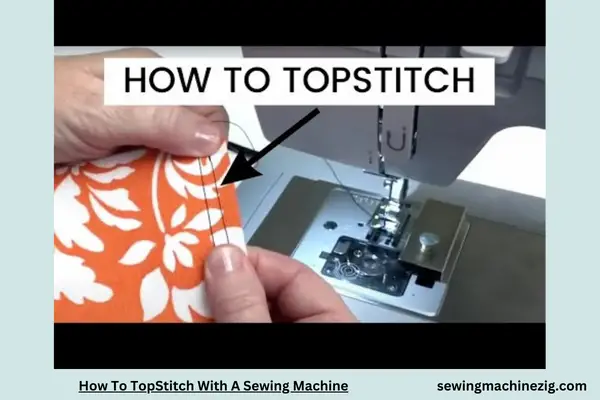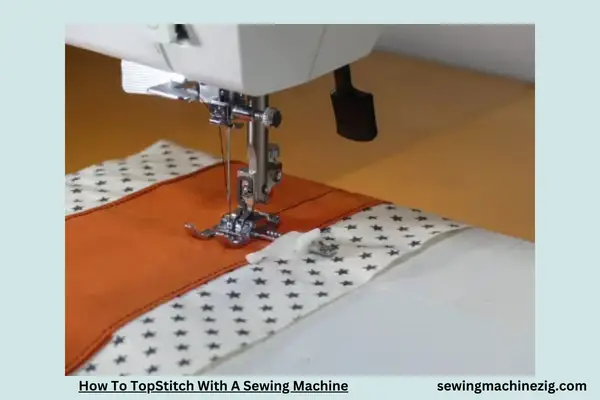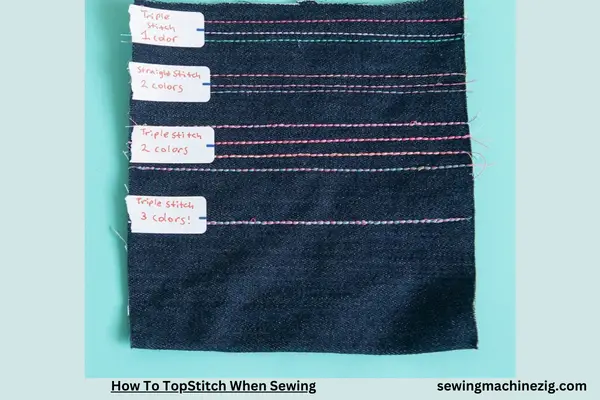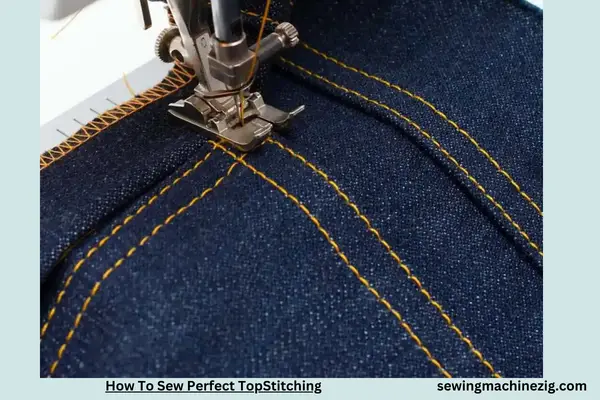
Elevating your sewing projects to professional precision often hinges on mastering the art of topstitching with a sewing machine. This crucial skill adds both durability and aesthetic appeal to your creations. If you’re venturing into the realm of topstitching, understanding the nuances of your sewing machine becomes paramount.
In this comprehensive guide, How To TopStitch With A Sewing Machine, We’ll unravel the steps and techniques on how to topstitch with a sewing machine. From selecting the right needle to adjusting tension, delve into the intricacies of this essential sewing skill to achieve flawless and polished results in every stitch.
How To TopStitch With A Sewing Machine Detailed Answer

Topstitching, when executed with precision, can elevate your sewing projects to a level of professional finesse.
In this comprehensive step-by-step guide, “How To TopStitch With A Sewing Machine, We’ll delve into the intricacies of how to topstitch with a sewing machine, ensuring your stitches are not only functional but also aesthetically pleasing.
Step 1: Choose the Right Needle and Thread
Begin by selecting a needle suitable for your fabric weight. For topstitching, a slightly heavier needle is often recommended. Match it with a high-quality topstitching thread in a color that complements your fabric.
Step 2: Set Up Your Sewing Machine
Attach a topstitching foot to your sewing machine, which provides better visibility and control. Adjust the machine’s stitch length, typically between 3.0 and 3.5, for a balanced topstitch.
Step 3: Mark Your Stitching Line
Use tailor’s chalk or washable fabric markers to draw a guideline for your topstitching. This ensures straight, even stitches, especially crucial when working on visible seams.
Step 4: Practice on Scrap Fabric
Before diving into your main project, practice topstitching on a scrap piece of fabric. This allows you to get comfortable with the machine settings and ensures your chosen thread and needle combination produces the desired results.
Step 5: Secure the Beginning and End
Start your topstitching by backstitching a few stitches to secure the beginning. When reaching the end, backstitch again to prevent unraveling. Trim excess threads neatly for a polished look.
Step 6: Maintain Consistent Seam Allowance
Consistency is key in topstitching. Pay close attention to your seam allowance, keeping it uniform throughout the project. This consistency contributes to a professional and polished appearance.
Step 7: Guide the Fabric Smoothly
Guide the fabric evenly through the machine, avoiding tugging or pulling. Let the machine do the work, and use your hands to gently guide the fabric along the marked stitching line.
Step 8: Pivot at Corners
When topstitching around corners or curves, pause with the needle down, lift the presser foot, and pivot the fabric. This technique ensures a seamless transition and maintains a clean, professional look.
Step 9: Experiment with Stitch Styles
Explore different stitch styles for topstitching, such as a single or double row of stitches. Some projects may benefit from decorative stitches, adding a touch of flair to your finished piece.
Step 10: Press and Finish
After completing your topstitching, press the fabric to set the stitches and give your project a polished appearance. Admire the professional finish you’ve achieved through meticulous topstitching.
Step 11: Troubleshoot and Adjust
If you encounter any issues during topstitching, such as skipped stitches or tension problems, troubleshoot by rethreading the machine, checking the needle, or adjusting the tension settings.
Mastering how to topstitch with a sewing machine is a valuable skill that adds a layer of sophistication to your creations.
By following these detailed steps, How To TopStitch With A Sewing Machine, You can achieve professional-looking results, turning ordinary seams into visually appealing elements of your sewing projects. Experiment with different fabrics, threads, and techniques to enhance your topstitching proficiency, and take pride in the refined finish you bring to your handmade garments and accessories.
How To TopStitch When Sewing

Topstitching is a sewing technique that involves stitching on the outside of a garment or project, often along seams or edges.
Here’s a straightforward guide on how to topstitch:
Choose the Right Thread and Needle:
- Select a thread that complements your fabric, and choose a needle suitable for the fabric weight. A slightly heavier thread and needle are often used for topstitching.
Set Up Your Sewing Machine:
- Thread your sewing machine with the chosen thread and insert the appropriate needle. Consider using a topstitching needle for better results. Ensure your machine is set to a straight stitch.
Adjust Stitch Length:
- Increase the stitch length slightly, typically between 3.0 and 3.5. A longer stitch length is often preferred for topstitching as it provides a more visible and decorative effect.
Choose the Right Presser Foot:
- Attach a topstitching foot or an edge-stitching foot to your sewing machine. These feet have a guide that helps keep your stitches straight and even.
Mark Stitching Lines:
- Use tailor’s chalk or another fabric marker to mark the stitching lines on your fabric. This ensures that your topstitching is straight and aligned.
Practice on Scrap Fabric:
- Before topstitching your main project, practice on a scrap piece of fabric. This allows you to get comfortable with the machine settings and ensures that the thread tension is correct.
Secure the Beginning and End:
- Backstitch at the beginning and end of your topstitching to secure the stitches and prevent unraveling. Trim any excess threads neatly.
Maintain Consistent Seam Allowance:
- Pay attention to your seam allowance and keep it consistent. Consistency in seam allowance ensures even and professional-looking topstitching.
Guide the Fabric Smoothly:
- Guide the fabric smoothly under the presser foot. Keep an eye on the marked stitching lines and use them as a guide for straight and even stitching.
Pivot at Corners:
- When reaching corners or curves, pause with the needle down, lift the presser foot, pivot the fabric, and continue stitching. This technique ensures a clean and seamless transition.
Press the Topstitched Area:
- After completing the topstitching, press the stitched area with an iron. This sets the stitches and gives your project a polished and professional finish.
By following these steps, you can master the art of topstitching and add a polished and decorative touch to your sewing projects.
How To Sew Perfect TopStitching

Achieving perfect topstitching is a skill that can enhance the look and durability of your sewing projects. Here’s a simple guide on how to topstitch with a sewing machine and sew perfect topstitching:
Select the Right Thread and Needle:
- Choose a thread that complements your fabric and a needle suitable for the fabric’s weight. A slightly heavier thread and a topstitching needle can contribute to more visible and defined stitches.
Set Up Your Sewing Machine:
- Thread your sewing machine with the chosen thread and ensure your machine is set to a straight stitch. Consider using a topstitching or an edge-stitching foot for precise guidance.
Adjust Stitch Length:
- Increase the stitch length slightly, typically between 3.0 and 3.5. A longer stitch length is often preferred for topstitching as it provides a more prominent and decorative look.
Mark Stitching Lines:
- Use a tailor’s chalk or a fabric marker to mark the stitching lines on your fabric. These marks act as a guide, ensuring your topstitching with a sewing machine is straight and even.
Practice on Scrap Fabric:
- Before working on your main project, practice topstitching on a scrap piece of fabric. This allows you to familiarize yourself with the machine settings and ensures the correct thread tension.
Secure the Beginning and End:
- Backstitch at the beginning and end of your topstitching to secure the stitches. This prevents them from unraveling. Trim any excess threads neatly.
Maintain Consistent Seam Allowance:
- Pay close attention to your seam allowance and keep it consistent. Consistency in seam allowance ensures that your topstitching looks even and professional.
Guide the Fabric Smoothly:
- Guide the fabric smoothly under the presser foot. Follow the marked stitching lines closely, using them as a guide for straight and precise How To TopStitch With A Sewing Machine.
Pivot at Corners:
- When you reach corners or curves, pause with the needle down, lift the presser foot, pivot the fabric, and continue stitching. This technique ensures a smooth and seamless transition.
Press the Topstitched Area:
- After completing the topstitching, press the stitched area with an iron. This helps set the stitches and gives your project a polished and professional finish.
By following these straightforward steps, How To TopStitch With A Sewing Machine machine and elevate the overall quality and appearance of your sewing creations. Practice, attention to detail, and patience will contribute to mastering this valuable sewing skill.
Conclusion
In conclusion, mastering how to topstitch with a sewing machine is a valuable skill for enhancing the professional look and durability of your creations. By selecting the right thread and needle, adjusting your machine settings, and maintaining a consistent seam allowance, you can achieve precise and decorative topstitching.
Remember to practice on scrap fabric to perfect your technique and explore various design possibilities. With patience and attention to detail, topstitching becomes a rewarding aspect of your sewing repertoire, elevating the overall quality of your projects.
FAQS
Q1: How do I thread a Necchi sewing machine?
A1: Topstitching is a visible stitch sewn on the exterior of a garment or project. It serves both decorative and functional purposes, adding a polished look and securing layers of fabric.
Q2: Can I use any sewing machine for topstitching?
A2: Yes, you can use any sewing machine for topstitching. Ensure you have the appropriate needle, thread, and presser foot for optimal results.
Q3: What type of thread is best for topstitching on a sewing machine?
A3: For visible and durable topstitching, use a quality thread that complements your fabric. Heavy-duty or topstitching thread is often recommended.
Q4: How do I set up my sewing machine for topstitching?
A4: Set your sewing machine to a straight stitch, choose an appropriate needle, and adjust the stitch length according to your project. Practice on scrap fabric to fine-tune settings.
Q5: Is there a specific presser foot for topstitching?
A5: Yes, use a topstitching foot for precise and even topstitching. This foot typically has a guide to help maintain consistent stitching.
Q6: Can I topstitch curves and corners with a sewing machine?
A6: Yes, topstitching can be done on curves and corners. Use a slower stitching speed and pivot as needed to navigate these areas smoothly.



